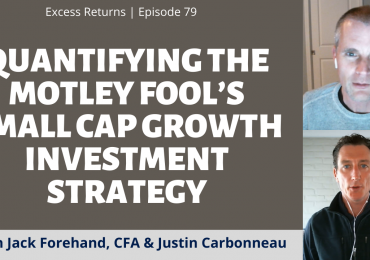In his bi-weekly Hot List newsletter, Validea CEO John Reese offers his take on the markets and investment strategy. In the latest issue, John talks about some of the current fears in the market, and why they aren’t deterring him from buying stocks.
Excerpted from the Jan. 18, 2013 issue of the Validea Hot List newsletter
Fear Factor
The 2013 year has started off with a bang for investors, with the S&P 500 already up about 4% (through yesterday). In many cases, a 4% gain over two weeks would be a sign that investors are feeling pretty good about things. Not so with this 4% gain, however. Clouds continue to hover over the investment world — some fear that the U.S. debt ceiling battle won’t be resolved, causing America to default on its debt for the first time ever; some say earnings estimates are still too high, and that growth is going to grind to a halt at some point this year; and some fear that turmoil in the Middle East will jolt markets sometime soon.
Those issues are all legitimate and must be dealt with. But, frankly, from an investment perspective, their presence is probably a bullish factor. All you have to do is look at the past few years to understand why. Since 2008, the financial world has jumped from fears of a global economic and financial system collapse, to fears of Middle East turmoil causing major oil market disruptions, to fears of a Eurozone demise, to fears of a U.S. default, to fears of the U.S. fiscal cliff, and now back to fears of a U.S. default. And, while all of those issues were serious ones, each time the fear turned out to be worse than the reality. We have not fallen into a depression; the Eurozone has not collapsed; the U.S. did not belly flop off the fiscal cliff. In fact, things have improved quite a bit in recent years. Unemployment has fallen from a peak of 10% down to 7.8%; the service sector has expanded every month for the past three years; housing starts are way up, as are home prices; and the stock market is up nearly 120% from its March 2009 low.
Fears being worse than reality isn’t anything new in the investment world. We humans are emotional creatures, and we tend to overreact to news (both on the downside and the upside. And in late 2008 and early 2009, things got so scary that many have become particularly prone to thinking that the worst is going to happen whenever problems emerge. The media doesn’t help — doom and gloom has been dominating the headlines for years now, drowning out the many positive signs that have emerged. Having been caught with their pants down when the 2008 crisis hit, I think most news outlets are leaning toward the negative side, fearing that they will lose more credibility if they fail to see another crisis coming. Plus, let’s face it: Negative news attracts more viewers and readers.
But remember, fear is an investor’s ally. Warren Buffett has famously said that “if [investors] insist on trying to time their participation in equities, they should try to be fearful when others are greedy and greedy only when others are fearful.” His fellow investing great, Peter Lynch, has also stressed the importance of not giving into fear, once saying that “the real key to making money in stocks is not to get scared out of them.”
That advice goes for both the broader market, and individual stocks. In a September 2011 interview on CNBC, Joel Greenblatt, another of the great investors upon whom I base my strategies, explained the common thread among the companies that his quantitative system tends to target: “Each one of those companies is hated brutally by people,” he said. At the time, Greenblatt was very bullish on stocks, even though the marketplace was filled with fear. “It’s a very scary time to invest,” he said, “and that’s when you get your best bargains.” In the 16 months since that interview, the S&P 500 is up about 26%.
The Hot List has often benefited from other investors’ fears over the years. Perhaps most recently, it did so with its pick of Nu Skin Enterprises. Nu Skin shares were been pummeled for much of 2012, taking a particularly big hit in December. Part of the reason probably involved the fact that it’s a more economically sensitive small-cap, the sort of stock hit hard by the fiscal cliff/recession fears. Part of it was also probably the fact that Nu Skin is a similar business to Herbalife, a firm that hedge fund guru David Einhorn recently said he is extremely bearish on. Nu Skin was likely thus hurt by guilt by association.
But the Hot List was more focused on Nu Skin’s fundamentals, which were quite good when it added the firm to the portfolio on Dec. 21. Since then, its shares have rebounded forcefully, gaining about 35%.
On today’s rebalancing, the Hot List is selling Nu Skin and three other positions and replacing them with four new stocks that now rate higher. This new quartet has its fair share of clouds hanging over it. Three of the stocks — Hibbett Sports, rue21, and Guess? — are retailers. And with the debt ceiling issue and other economic concerns dogging investors, many fear retailers — which have excelled since the March 2009 bottom — have come to the end of their run.
But look at the numbers: Guess? has upped earnings per share in 8 of the past 10 years. Hibbett has done so in 9 of the last 10. Rue21 has done so in all 10. All of them increased EPS in 2008 and 2009, when the Great Recession was occurring. Together, the three companies are averaging a return on equity of nearly 20% over the past 10 years. Among them, they have a total of just $8.7 million in debt, and more than $1 billion in net current assets.
Those are some great fundamentals. But because of the economic fears, the prices of these three stocks are quite reasonable. The fourth addition to the portfolio, meanwhile, is downright dirt-cheap. Despite having about five times as much annual earnings as debt and $3.85 in free cash flow per share, Northrop Grumman shares trade for 8.6 times trailing 12-month EPS, 9 times projected 12-month EPS, and 0.65 times sales. The reason? The big budget cuts that would go into effect if Congress and the President can’t reach a compromise on the budget aspects of the fiscal cliff, which weren’t addressed by the deal reached earlier this month. Budget cuts, with or without a deal, are no doubt a legitimate threat, but current estimates for Grumman in 2013 already include a significant profit cut. In fact, even if profits fell by 40% in 2013, at its current price Grumman would be trading at a very reasonable P/E of about 15. Investors certainly seem to be overreacting.
All in all, fears may not be as intense right now as they’ve been at other points in the past four years. They remain, however, and no doubt will wax and wane at different points in 2013. But fear in and of itself isn’t a reason to sell a stock or jump out of the market altogether. Good investors have rational, systematic approaches that determine when to sell, or when to lighten up on an asset class. And, after more than a dozen years studying history’s most successful investors, I can tell you this: Far more often than not, the greatest strategists saw times of fear, or stocks that were feared, as some of the biggest sources of opportunity. However events unfold in 2013, that’s something to keep in the forefront of your mind.








Comments are closed.